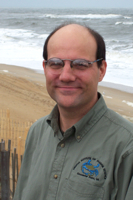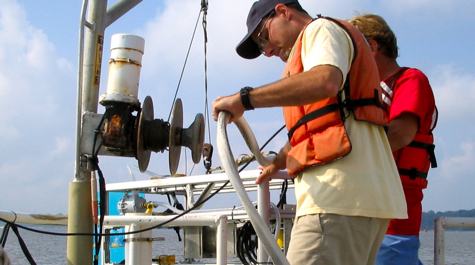VIMS prof wins grant to study wind’s effect on “dead zones”
VIMS professor Carl Friedrichs and colleagues at the University of Maryland and Old Dominion University have received a three-year grant from the National Science Foundation to observe and model how wind affects the development of low-oxygen “dead zones” in Chesapeake Bay and the York River.
Dead zones—areas of seafloor with too little oxygen for most marine life—are a growing problem in coastal waters worldwide, including estuaries like Chesapeake Bay.
 Friedrichs and his colleagues note that two main factors contribute to dead-zone formation. Perhaps most familiar are the blooms of algae that form when excessive loads of nitrogen—from fertilizers, municipal sewage, and other sources—runoff into coastal waters. When these algae die and sink, they provide a rich food source for bacteria, which in the act of decomposition take up dissolved oxygen from the surrounding environment.
Friedrichs and his colleagues note that two main factors contribute to dead-zone formation. Perhaps most familiar are the blooms of algae that form when excessive loads of nitrogen—from fertilizers, municipal sewage, and other sources—runoff into coastal waters. When these algae die and sink, they provide a rich food source for bacteria, which in the act of decomposition take up dissolved oxygen from the surrounding environment.
A less familiar control on dead-zone formation—the one Friedrichs and his colleagues will be studying—is the wind’s effect on stratification of the water column. Stratification is common in estuaries, where input of relatively fresh water from rivers tends to form a surface layer atop colder and saltier water from the sea. This stratification can prevent the mixing or dissolution of atmospheric oxygen into deeper waters—thus promoting the development or persistence of dead zones.
Until recently, scientists had thought that the main force acting to disrupt stratification—and thus alleviate dead zones—was the daily ebb and flow of the tides. Friedrichs, along with collaborators at the University of Maryland Center for Environmental Science and Old Dominion University’s Center for Coastal Physical Oceanography, will test a different idea—that wind also plays an important role in estuarine circulation and mixing.
“The physical workings of an estuary depend on the outcome of a contest between forces acting to stratify its waters, and forces acting to destroy this stratification,” notes Friedrichs. “For six decades, the prevailing scientific wisdom was that tides provided the destructive force, by generating turbulence through ebb and flow over the rough bottom. In recent years, a new player has emerged—wind blowing over the estuary.”
The research team will study wind and its potential effects on stratification by deploying a suite of traditional and cutting-edge weather and oceanographic instruments. These include anemometers to measure wind speed and direction, Acoustic Doppler current profilers and velocimeters to measure current speed and direction, and CT sensors to record water temperature and salinity. They’ll deploy these instruments from a fixed tower and an array of buoys in the middle reaches of Chesapeake Bay and in the York River. They will also use a pair of research vessels to tow a “Scanfish” through local waters, measuring its density in three dimensions.
Data from these sensors will be fed into a computer model whose output will help the researchers better understand the relative effects of tides and wind on estuarine stratification. This improved understanding will ultimately help guide management efforts to reduce the duration and severity of dead zones in Chesapeake Bay and other coastal waters.
“Costly programs are planned and underway to restore the health of our nation’s estuaries,” says Friedrichs. “These management programs will need an accurate description of the physics of estuarine circulation if they are to be successful.”
The multi-institutional research team is led by Dr. Bill Boicourt of the University of Maryland Center for Environmental Science and includes Dr. Malcolm Scully of Old Dominion University. Scully is a 2005 graduate of the College of William and Mary’s School of Marine Science at VIMS.


